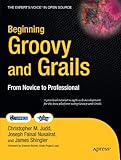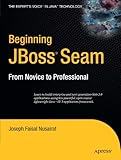Joseph Nusairat
Co-Author of Beginning Groovy & Grails

Joseph Faisal Nusairat, author of “Beginning JBoss Seam” and co-author “Beginning Groovy & Grails”, is a Java developer who has been working full time in the Columbus Ohio area since 1998, primarily focused on Java development. His career has taken him into a variety of Fortune 500 industries including military applications, data centers, banking, internet security, pharmaceuticals, and insurance. Joseph is particularly fond of open source projects and tries to use as much open source software as possible when working with clients. Joseph is a graduate of Ohio University with dual degrees in Computer Science and Microbiology with a minor in Chemistry. Currently, Joseph works as a Senior Partner at Integrallis Software (www.integrallis.com).
PRESENTATIONS
BOOKS
Beginning Groovy and Grails: From Novice to Professional
Web frameworks are playing a major role in the creation of today's most compelling web applications, because they automate many of the tedious tasks, allowing developers to instead focus on providing users with creative and powerful features. Java developers have been particularly fortunate in this area, having been able to take advantage of Grails, an open source framework that supercharges productivity when building Java–driven web sites. Grails is based on Groovy, which is a very popular and growing dynamic scripting language for Java developers and was inspired by Python, Ruby, and Smalltalk.
Beginning Groovy and Grails is the first introductory book on the Groovy language and its primary web framework, Grails.
This book gets you started with Groovy and Grails and culminates in the example and possible application of some real–world projects. You follow along with the development of each project, implementing and running each application while learning new features along the way.
Beginning Groovy and Grails: From Novice to Professional
Web frameworks are playing a major role in the creation of today's most compelling web applications, because they automate many of the tedious tasks, allowing developers to instead focus on providing users with creative and powerful features. Java developers have been particularly fortunate in this area, having been able to take advantage of Grails, an open source framework that supercharges productivity when building Java–driven web sites. Grails is based on Groovy, which is a very popular and growing dynamic scripting language for Java developers and was inspired by Python, Ruby, and Smalltalk.
Beginning Groovy and Grails is the first introductory book on the Groovy language and its primary web framework, Grails.
This book gets you started with Groovy and Grails and culminates in the example and possible application of some real–world projects. You follow along with the development of each project, implementing and running each application while learning new features along the way.
What you’ll learn
- Understand the fundamentals of the open source, dynamic Groovy scripting language and the Grails web framework.
- Capitalize upon Grails’ well–defined framework architecture to build web applications faster than ever before.
- Improve your web application with cutting–edge interface enhancements using Ajax.
- Use Grails’ object–relational mapping solution, GORM, to manage your data store more effectively than ever before.
- Take advantage of Groovy to create reporting services, implement batch processing, and create alternative client interfaces.
- Deploy and upgrade your Grails–driven applications with expertise and ease.
- Discover an alternative client in Groovy as well.
Who this book is for
Java and web developers looking to learn and embrace the power and flexibility offered by the Grails framework and Groovy scripting language.
Beginning JBoss Seam: From Novice to Professional
JBoss Seam represents the primary counter to the hot and successful Spring Framework and perhaps even Ruby on Rails framework. The open source lightweight Java EE 5 standards based JBoss Seam framework is a part of this second wave of open source lightweight Java that’s taking place. This book aims to take advantage of this hot area. It gives an overview of Seam related JSF and EJB 3 as found in Java EE 5. It provides information on the tools to make development with Seam easier as well as a functioning in depth demo to truly learn how to use Seam. Tips and tricks to using Seam are also included.



